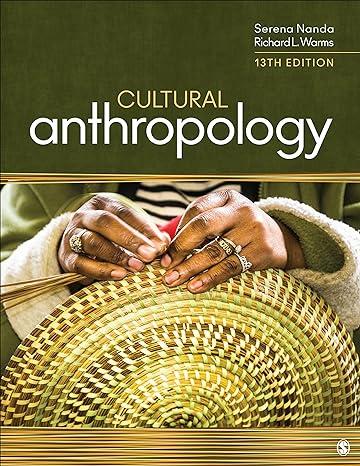What are some important connections between kinship and transmigration? Kinship relations are an important factor in the
Question:
What are some important connections between kinship and transmigration?
Kinship relations are an important factor in the migration of people across state borders-a significant dimension of globalization. The importance of kinship in this process is apparent in the criteria by which immigration rights and citizenship are granted in most nations of the world. In the United States, the priority of kinship and the cultural importance of bilateral kin relations are basic to immigration policy. In 1965, 1978, and 1990, new immigration laws abolished the discriminatory national origins quota system of the 1920s and emphasized family reunification. The current preference system, which gives the highest priority to members of the nuclear family, indicates U.S. cultural priorities and reflects U.S. bilateral kinship: Preferences are given to spouses and biological children. A lower preference is given to brothers and sisters, their spouses, and their children.
Immigration policies that make it easier for kin to come to the United States as well as high levels of illegal immigration (often to join family members) have led to a large foreign-born population in the country. In 1970, less than \(5 \%\) of the U.S. population was foreign born. By 1994, that number had risen to almost \(9 \%\), and by 2018 , it had risen to \(13.7 \%\) (Pew Research Center, 2020).
There are important differences between immigration today and immigration 100 years ago. In the past, most immigrants more or less severed ties with kin who stayed behind. Travel was difficult and expensive. The only way most kin could keep in contact was by letters. Immigrants today live in a world where communication by telephone, e-mail, and the Internet is abundant, relatively simple, and inexpensive. Air travel is within the reach of the middle and working classes. Thus, many immigrants, especially those from nearby areas such as the Caribbean, can retain much closer social and economic ties with their families and cultures in their homelands than was previously possible. This pattern of close ties and frequent visits by immigrants to their home countries is called transnationalism.
The term transmigrant refers to immigrants who maintain close relations with their home countries (Glick-Schiller et al., 1995). Transmigrants move culture, money, and information around the world rapidly, often through kin networks. The substantial amounts of money migrants send to their families back home are critical in the economies of many nations and, by extension, in the global economy. According to the World Bank, in 2021, immigrants around the world sent \(\$ 589\) billion home to low- and middle-income countries (Ratha, 2021). Globally, about one in nine people are supported by such remittances (UN, 2019). In some cases, remittances play a critical role in national budgets. For example, in Tonga, Lebanon, Honduras, El Salvador, and Nepal, remittances in 2021 were equivalent to more than a quarter of the nation's total economic output (KNOMAD, 2021). Money sent home by migrants offers assistance for kin left behind both in their domestic lives and in the building of communities. However, it also leaves these relatives vulnerable to changes in the global economy.
Step by Step Answer:






